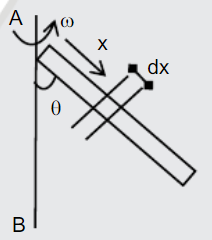A ceiling fan rotates about its own axis with some angular velocity. When the fan is switched off, the angular velocity becomes (14)th of the original in time 't' and 'n' revolutions are made in that time. The number of revolutions made by the fan during the time interval between switch of and rest are (Angular retardation is uniform)
4n15
8n15
16n15
32n15
The correct Answer is:C
To solve the problem step-by-step, we will use the equations of rotational motion.
Step 1: Identify the given data
- Initial angular velocity: ω0
- Final angular velocity after time t: ω=14ω0
- Time taken: t
- Number of revolutions made during time t: n
Step 2: Use the equation of motion for angular velocity
The equation of motion for angular velocity in rotational dynamics is given by:
ω2=ω20+2αθ
Where:
- α is the angular retardation (negative because the fan is slowing down)
- θ is the angular displacement in radians
Step 3: Substitute the known values
Substituting ω=14ω0 and θ=2πn into the equation:
(14ω0)2=ω20+2(−α)(2πn)
This simplifies to:
116ω20=ω20−4πnα
Step 4: Rearranging the equation
Rearranging gives:
4πnα=ω20−116ω20
4πnα=1616ω20−116ω20=1516ω20
Thus, we can express α in terms of n:
α=15ω2064πn
Step 5: Find the total number of revolutions until rest
Using the equation again for the total angular displacement until the fan comes to rest:
0=ω20+2(−α)θ′
Where θ′ is the total angular displacement until rest. Rearranging gives:
θ′=ω202α
Step 6: Substitute α
Substituting the expression for α:
θ′=ω202(15ω2064πn)=64πn30=32πn15
Step 7: Convert angular displacement to revolutions
To convert θ′ from radians to revolutions:
Number of revolutions=θ′2π=32πn152π=32n30=16n15
Final Answer
Thus, the total number of revolutions made by the fan during the time interval between switch off and rest is:
n′=16n15
- Initial angular velocity: ω0
- Final angular velocity after time t: ω=14ω0
- Time taken: t
- Number of revolutions made during time t: n
The equation of motion for angular velocity in rotational dynamics is given by:
ω2=ω20+2αθ
Where:
- α is the angular retardation (negative because the fan is slowing down)
- θ is the angular displacement in radians
Substituting ω=14ω0 and θ=2πn into the equation:
(14ω0)2=ω20+2(−α)(2πn)
This simplifies to:
116ω20=ω20−4πnα
Rearranging gives:
4πnα=ω20−116ω20
4πnα=1616ω20−116ω20=1516ω20
Thus, we can express α in terms of n:
α=15ω2064πn
Using the equation again for the total angular displacement until the fan comes to rest:
0=ω20+2(−α)θ′
Where θ′ is the total angular displacement until rest. Rearranging gives:
θ′=ω202α
Substituting the expression for α:
θ′=ω202(15ω2064πn)=64πn30=32πn15
To convert θ′ from radians to revolutions:
Number of revolutions=θ′2π=32πn152π=32n30=16n15
Thus, the total number of revolutions made by the fan during the time interval between switch off and rest is:
n′=16n15
Similar Questions
A cylinder of water, is rotating about its own axis with uniform angular velocity ω. The shape of free surface of water will be
View SolutionA fly wheel is rotating about its own axis at an angular velocity 11rads−1, its angular velocity in revolution per minute is
View SolutionThe angular velocity of a wheel increases from 100 to 300 in 10 s. The number of revolutions made during that time is
View SolutionA rod is rotating with angular velocity ω about axis AB. Find cosθ.

View SolutionA circular disc is rotating about its own axis at uniform angular velocity ω. The disc is subjected to uniform angular retardation by which its angular velocity is decreased to ω/2 during 120 rotations., The number of rotations further made by it before coming to rest is
View SolutionThe angular velocity of a wheel rotating with constant angular acceleration, changes from 2 rad/s to 6 rad/s in a time interval of 31.4 s. The number of rotations made by the wheel in this interval of time is
View SolutionA circular disc is rotating about its own axis at an angular velocity ω. If P is exact midpoint of dise between axis and rim of disc then angular velocity of Pis
View SolutionWhich is greater , the angular velocity of the hour hand of a watch or angular velocity of earth around its own axis ?
View SolutionWhat is the angular velocity of a particle lying on the axis of rotation ?
View SolutionWhat is the angular velocity of a particle lying on the axis of rotation ?
View Solution
